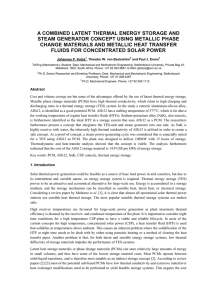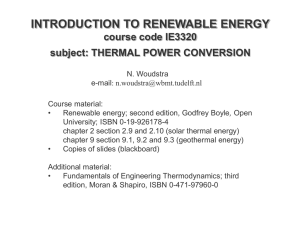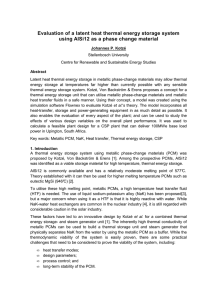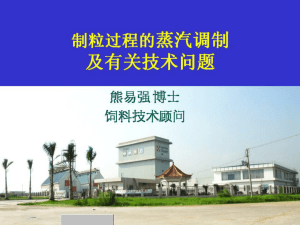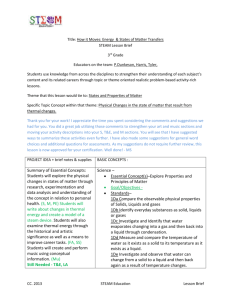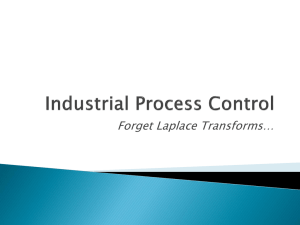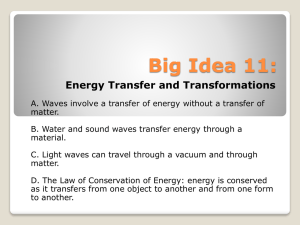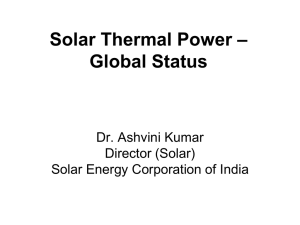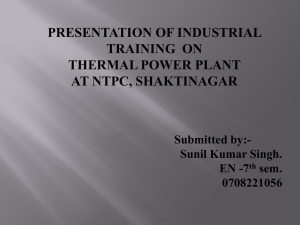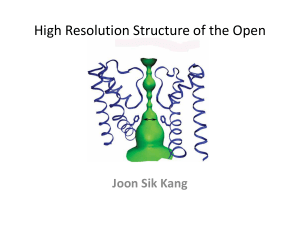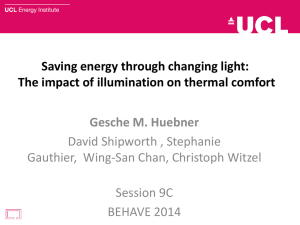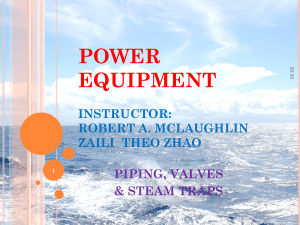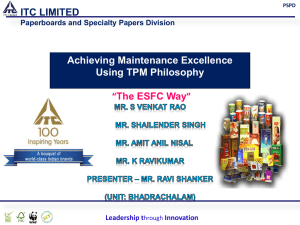Kotze_J - Energy Postgraduate Conference
advertisement
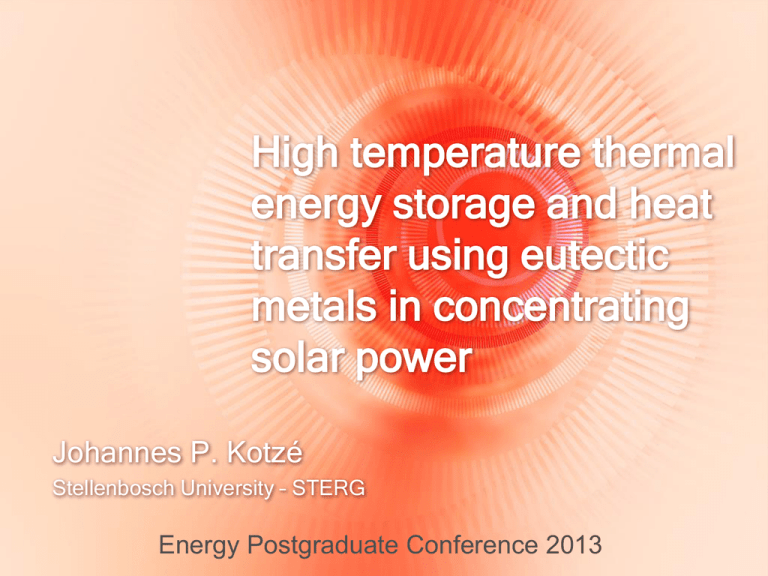
High temperature thermal energy storage and heat transfer using eutectic metals in concentrating solar power Johannes P. Kotzé Stellenbosch University – STERG Energy Postgraduate Conference 2013 Thermal energy storage – State of the art • • • • Two tank molten salt 565°C Subcritical steam Power block efficiency: – 36-40% • Excellent from a thermodynamic point of view but limited thermal efficiency Cost breakdown of a CSP plant – US-DOE Cost breakdown of LCOE (All costs) Heliostat cost 22.1 % Indirect costs 20.8 % Operations and maintenance 12.1 % Power plant cost 12.1 % Receiver cost 10.1 % Tax 8.1 % Storage cost 7.4 % Balance of plant cost 4.0 % Site cost 2.0 % Tower cost 1.3 % • • • DOE – CSP calculation at 15 US$ cents/kWh 41% of the costs are due to indirect costs and is site specific Still, heliostats relates to 37.5% of the total hardware cost Increased thermal efficiency (less heliostats) Heliostat cost reduction Most direct path for cost reduction Most direct path to cost reduction • Consider a 10% increase in thermal efficiency from a usual subcritical steam power block to a ultra supercritical steam power block: – 26.3% savings in thermal input from the heliostats. – 26.3% less heliostats – And a 5.8% reduction in LCOE, and a 9.8% reduction in plant cost based on heliostats alone. • Requires higher temperature thermal storage temperatures Technology Source temperature Thermal efficiency Subcritical steam 540°C ~36%-40% Ultra supercritical steam 600°C ~48%-52% CO2 Brayton cycles (S-CO2) 550°C ~45% Metallic PCM’s 800.00 Si(56)–44Mg LFC CPC/CTC 700.00 PTC Selected alloy for research is AlSi12: PTC with steam 600.00 PDR/HFC Latent heat of fusion (J/g) 87.76Al–12.24Si 500.00 88% Aluminium, 12% Silicon (by mass) Melting point : ±577 °C Heat of fusion : 490 to 546 J/g Density@ 577 °C : ± 2650 kg/m^3 Thermal conductivity @ 577 °C : ± 190 W/m.K Low cost casting alloy known as AA4047 or LM6 [4] 83.14Al–11.7Si–5.16Mg 86.4Al–9.4Si–4.2Sb Cu(56)–27Si–17Mg 46.3Al–4.6Si–49.1Cu 400.00 64.1Al–5.2Si–28Cu–2.2Mg 60.8Al–33.2Cu–6.0Mg Al(59)–35Mg–6Zn 300.00 Al(65)–30Cu–5Si Cu(69)–17Zn–14P 66.92Al–33.08Cu 68.5Al–5.0Si–26.5Cu Mg(47)–38Si–15Zn 64.3–34.0Cu–1.7Sb Al(54)–22Cu–18Mg–6Zn 34.65Mg–65.35Al 46.3Mg–53.7Zn 96Zn–4Al Zn(49)–45Cu–6Mg Mg(55)–28–17Zn [5] Mg2Cu Mg(52)–25Cu–23Ca 200.00 Si(49)–30Mg–21Ca Mg(84)–16Ca Zn2Mg Mg(60)–25Cu–15Zn [5] Cu (91)–9P Cu(80)–20Si Cu(74)–19Zn–7Si Cu(83)–10P–7Si 100.00 0.00 0.00 100.00 200.00 300.00 400.00 500.00 600.00 700.00 800.00 900.00 1000.00 Melting temperature (°C) • • • Higher storage temperatures possible High thermal conductivity – Less complicated heat exchanger design High density storage Metallic heat transfer fluids - NaK Heat transfer fluid Liquid sodium Molten nitrate salt Steam vapour Air NaK eutectic system NaK receiver capable of 3MW/m2 Water Sodium (atm) NaK46 (10bar) NaK78 (atm) Thermal oil Hitec Solar Salt Hitec Hitec XL -50 0 50 100 150 200 250 300 350 400 450 500 550 600 650 700 750 800 850 900 950 1000 1050 1100 Operational Temperature - C Peak flux (MW/m2) 1.5 0.8 0.4 0.22 • Sodium – Potassium alloy (NaK) • Eutectic composition: • 77.8% potassium • Melts at -12.8°C (no trace heating) • Traditionally used in experimental nuclear reactors for safety reasons • Highly reactive with water • NaK46 is better suited for solar applications • 46% potassium • 20°C melting point • Higher specific heat capacity • Compact and economic receiver design for even higher efficiency. Concept evaluation Steam/ Water out NaK in: 780°C NaK to storage AlSi12 PCM Re-heater Housing Steam/water pipes Steam drum AlSi12 PCM NaK Pipes G Superheater HP-Turbine IP-Turbine LP-Turbine Boiler Collector field NaK to Recievers NaK out: 577°C Steam/ Water in Cross-section • Combined storage and steam generator concept • Design tool: Flownex SE • 100MW electrical output • Subcritical steam cycle • Aim is to investigate design methodology and process control parameters FW Pump O-FWH FW Pump Condenser Heat transfer analysis: Stefan problem • Two key components to analysis: – – • Heat transfer to the heat exchange pipes Tracking and predicting the solidification front in the melt This is a classical Stefan problem – – Solved using a enthalpy tracking method Heat of fusion is measured using DSC Experimental validation One way valve One way valve Header tank (Oil) TC Ball Valve Vapour condenser P Gate valve Heaters Primary oil coolant loop Test section cooling loop Ball Valve Test section Cooling tower Water cooling loop F Flow meter TC V-1 F Ball Valve Water pump TC Flow meter TC P Solenoid valve Dump tank Conclusions • • • • • Higher storage temperatures relate to lower LCOE Metallic phase change materials can offer storage temperatures that can be used with high efficiency power cycles Metallic heat transfer fluids, like NaK can offer high temperature heat transfer solutions, will not solidify at night, and results in high performance receiver designs. A concept was developed and evaluated. The design tools was evaluated using a experiment. The experiment serves as a prototype, and is a proof of concept .



